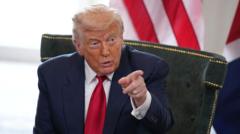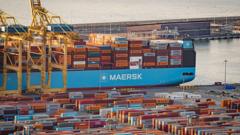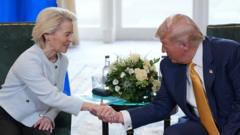The legal battles surrounding President Trump's tariffs are creating uncertainty and raising questions about the future of U.S. trade policy. With a recent court ruling paused, the administration's tariff strategy faces further scrutiny.
Legal Tug-of-War Over Tariffs Challenges Trump's Trade Agenda

Legal Tug-of-War Over Tariffs Challenges Trump's Trade Agenda
A series of court rulings regarding tariffs imposed by President Trump has thrown U.S. trade policy into disarray, potentially impacting global markets and American consumers.
In a dramatic turn of events, the ongoing saga surrounding President Trump’s contentious tariffs has thrown the administration's trade strategies and the broader economic landscape into disarray. What began as a decisive move by President Trump to impose hefty tariffs on foreign imports now rests precariously on the outcomes of legal battles that are capturing the attention of Washington, Wall Street, and global markets.
The turmoil started when the U.S. Court of International Trade issued a ruling that invalidated several of Trump’s tariffs, claiming the president overstepped his authority granted under a long-standing emergency economic law. The court argued that Congress did not authorize the unbounded powers exercised by the executive branch to initiate a global trade war, particularly with import taxes that weigh heavily on American consumers. The ruling had immediate implications, suggesting the potential for a significant reduction in tariffs over the coming days.
However, this was just the beginning of the turmoil. Just hours after the ruling, the government quickly sought to intervene, and a federal appeals court issued a temporary stay allowing the tariffs to remain in place. This pause essentially halted the potential unwind of Trump’s tariffs, which have added a minimum 10% levy on imports from nearly every global trading partner.
The federal appeals court decision has granted the administration additional time to argue its case, but the remaining uncertainty continues to loom large over the economy. Experts are now keenly observing how further rulings could shape the future of U.S. trade policy and the ramifications for consumers and businesses, who may face increased prices if Trump’s aggressive tariff strategy is upheld. This legal dilemma is expected to escalate, possibly reaching the Supreme Court, leaving many to ponder the ultimate fate of tariffs in America’s complex trade landscape.
The turmoil started when the U.S. Court of International Trade issued a ruling that invalidated several of Trump’s tariffs, claiming the president overstepped his authority granted under a long-standing emergency economic law. The court argued that Congress did not authorize the unbounded powers exercised by the executive branch to initiate a global trade war, particularly with import taxes that weigh heavily on American consumers. The ruling had immediate implications, suggesting the potential for a significant reduction in tariffs over the coming days.
However, this was just the beginning of the turmoil. Just hours after the ruling, the government quickly sought to intervene, and a federal appeals court issued a temporary stay allowing the tariffs to remain in place. This pause essentially halted the potential unwind of Trump’s tariffs, which have added a minimum 10% levy on imports from nearly every global trading partner.
The federal appeals court decision has granted the administration additional time to argue its case, but the remaining uncertainty continues to loom large over the economy. Experts are now keenly observing how further rulings could shape the future of U.S. trade policy and the ramifications for consumers and businesses, who may face increased prices if Trump’s aggressive tariff strategy is upheld. This legal dilemma is expected to escalate, possibly reaching the Supreme Court, leaving many to ponder the ultimate fate of tariffs in America’s complex trade landscape.



















